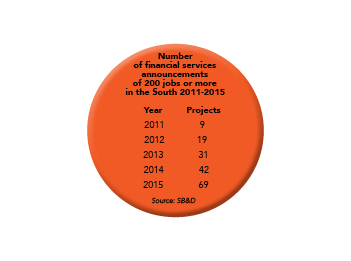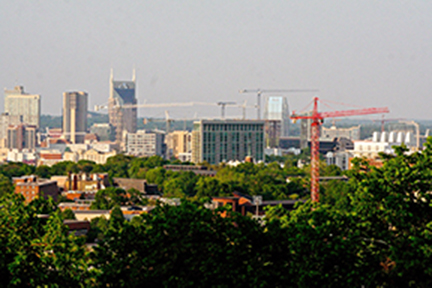
No industry was struck down as hard as the financial services industry during the Great Recession. From the mid-1990s through 2004, the sector was a massive job generator in states such as Florida, North Carolina, Texas and Virginia. Most every Southern state saw the financial services sector create thousands of jobs each year. Beginning in 2005 in Florida, where the first “housing crisis” started, financials began pink-slipping folks in unreal numbers. For example, from 1995 to 2004, financials averaged 47 projects creating at least 200 jobs in the American South. By 2008, that number had dropped to single digits. As late as 2011, only nine financial services projects of 200 jobs or more were announced in the region. In 2015, that number skyrocketed to 69. Over the last two years, many of those projects found Florida to their liking. Yes, Wall Street loves Florida. Office rents in places like Jacksonville, Tampa Bay and Orlando are about one-fourth the price of rents in New York. Firms such as Raymond James, Deutsche Bank, Bank of America, Citigroup, JP Morgan Chase and Goldman have created thousands of jobs in Florida since 2012 when the industry started to find its legs.

 More cranes in the air in Nashville than in New York
More cranes in the air in Nashville than in New York
The hits keep coming in Nashville, particularly from the construction industry where a bevy of major projects are being built in the city. According to a report from Rider Levett Bucknall, a real estate and construction consultant, Nashville has 27 tower cranes operating in the metro area. Most of the projects are high-rise offices, hotels and apartments. At the first of the year, New York had 21 cranes, San Francisco 24, Austin 20, Denver 18 and Boston had 11. Seattle had the most cranes with 62, according to the report, and Chicago had 56. Nashville has the lowest office vacancy of any city in the country at 6.2 percent. In the last quarter of 2016, the vacancy rate in Nashville was 4.6 percent.
Southern states top employee engagement list
A new report by Gallup showed that Alabama is the No. 1 state in the U.S. when it comes to employee engagement, with 37 percent of the state’s workers engaged in their jobs. Following Alabama were Kentucky, Delaware and Louisiana.
Southern MSAs dominate fastest growing manufacturing workforces
Metros in the South made up seven of the top 10 fastest growing manufacturing workforces, according to the Bureau of Labor Statistics. Since 2011, Louisville led all U.S. metros with 27.2 percent growth in manufacturing jobs. Nashville was second at 27 percent followed by Daytona Beach; Cape Coral-Fort Myers; Columbia, S.C.; Lakeland and Sarasota-Bradenton.
Winter hiring means economy still has room to grow
The Labor Department reported that 227,000 jobs were created in January and 235,000 in February. The fact that the unemployment rate fell to only 4.7 percent suggests that there is still room to grow the economy in the face of full employment pressures. Full employment drives up wages and inflation, but wages hardly grew in January. According to the Labor Department, about 7.5 million people are officially unemployed, with about 1.9 million of those out of work for longer than six months. With only 7.5 million officially unemployed, full employment should be attained this year.
Can we find enough legal workers to build a wall?
President Trump’s proposed infrastructure stimulus has a problem before it’s even begun — labor shortages. The unemployment rate in the construction trades is currently at 4.5 percent, the lowest in a decade. The labor shortage in the construction sector has already delayed announced factories, particularly in Texas and Louisiana in the South. “Contractors in general throughout the country have been saying it’s difficult to get workers,” said Ken Simonson, chief economist at the Associated General Contractors of America in a Bloomberg story published in the winter quarter. The fact that in Texas about half of all construction workers are undocumented makes the task of finding labor for large projects, such as the Southern U.S. border wall, even more difficult. In other words, it would be nearly impossible to find enough legal workers to build the wall in Texas.
 BMW is No. 1 vehicle exporter in the U.S.
BMW is No. 1 vehicle exporter in the U.S.
South Carolina-based BMW remained the No. 1 automobile exporter in the U.S. in 2016. The German automaker exported 287,700 SUV X models last year valued at $9.53 billion.
U.S. sets oil export record
U.S. shale oil producers exported 7 million barrels during a week in February, an all-time record. The record was set again the following week. The U.S. is exporting about the same amount of oil OPEC members have cut back on in recent months.
Six oil and gas states were in recession in 2016
S&P Global Ratings says six oil- and gas-producing states in the U.S. were in recession in calendar year 2016. Those states were Alaska, Louisiana, New Mexico, North Dakota, Oklahoma and Wyoming. Two other oil-producing states evaded recession — Texas and Montana.
FERC: Majority of new generating capacity from renewables in 2016
For the second consecutive year, the majority of electric generating capacity installed in the U.S. came from renewable sources such as wind, solar, biomass, geothermal and hydropower. The Federal Energy Regulatory Commission came out with a report in February that showed that renewables added 16,124 megawatts of power in 2016, or 61.5 percent of the total added, surpassing that of fossil fuels and nuclear power.
Dallas-Fort Worth second only to NYC in total construction starts
Dallas-Fort Worth construction starts hit a record in 2016, with almost $21 billion in new construction. Last year’s building starts were $2 billion more than the peak of the last construction cycle prior to the Great Recession. In 2016, only New York City had more construction starts than Dallas-Fort Worth.
DFW No. 1 market in leased office space
Dallas-Fort Worth led the nation in office leasing velocity in 2016. Last year, nearly 5.3 million square feet of office space was leased in the Dallas-Fort Worth metro area.
Houston’s office market has not bottomed out
While Houston’s economy may have finally stabilized after nearly three years of an oil sector crater, its office market has not stabilized completely as of yet. Newmark Grubb Knight Frank, a commercial real estate firm, claims that Houston’s office market vacancy rate is at 19.6 percent. But a wave of office construction will come online this year, delivering 2.4 million square feet of new office space. That will add about 1.4 million square feet of vacancy in the Houston market this year, according to the company.
Charlotte’s office market is in good shape
At the end of 2016, Charlotte’s office market had a vacancy rate of 8.5 percent, according to a Cushman & Wakefield report. Nearly 1.7 million square feet of office space was absorbed in metro Charlotte in 2016.
Missouri becomes last Southern state to pass right-to-work legislation
In the winter quarter, Missouri became the 28th state to bar mandatory union fees and dues from nonmembers. Passing the measure means that now all Southern states are right-to-work.
Midtown Atlanta is one of the South’s hottest urban submarkets
Several companies are expanding or moving into Midtown Atlanta to cozy up to Georgia Tech and the tech scene that has clustered there. NCR is moving its headquarters to Midtown, adding 3,000 employees. Anthem, Honeywell, Interface, Payscape, Kaiser Permanente and Sage Software are just a few of the many companies adding jobs in Midtown. Currently, about 12,000 new jobs are headed to the Midtown Atlanta submarket.
New Orleans tops in population growth
U.S. Census data shows that New Orleans is No. 3 among all major U.S. cities in population growth from 2010 to 2015. Since the measurement started five years after Katrina, it indicates that migration to New Orleans is more than a rebound phenomenon. The same Census data also showed that New Orleans is No. 1 in foreign-born population growth from 2010 to 2015. In the South, Charlotte, Oklahoma City, Nashville and Washington, D.C., all made the top 10 in foreign-born population growth during the period.
Texas is No. 1 for inbound moves
Texas was named the top state in the U.S. in U-Haul’s annual report on inbound moves. Corporate expansions and relocations by Toyota, Apple and Amazon, to name a few, are credited with the state attracting new residents.
Austin named best city to live
The annual U.S. News and World Report’s “Best Places to Live in America” came out in the winter quarter. Austin topped the ranking this year and Washington, D.C.; Fayetteville, Ark.; and Raleigh-Durham made the top 10.
Labor shortages showing up in Texas
In 2013 and 2014, Texas’ job generating machine was in high gear as the state created 361,000 jobs and 297,000 jobs respectively. In 2015, Texas created 175,700 jobs and in 2016, that total slightly improved to 210,200 jobs. The slowing job total in the South’s largest state doesn’t indicate that things are going poorly. It means that the state is running out of labor. Dallas-Fort Worth’s unemployment rate is 3.7 percent, Austin’s is 3.2 percent and San Antonio’s rate is 3.7 percent. Texas’ unemployment rate is 4.2 percent. Austin’s unemployment rate is below full employment, and project activity in the state’s capital has dropped dramatically in the last 18 months. The cooling off of Austin’s economy could be a good thing, as labor constraints could be eased.
U.S. jobless claims about as good as they get
In February, U.S. jobless claims dropped to 223,000. The last time initial unemployment filing claims were that low was in the 1970s, more than 40 years ago. But since the current U.S. labor force has gained millions since the 1970s, that 223,000 figure equates to about half of the low number last seen more than 44 years ago. The reasons for the low jobless claims are two-fold — there are currently very few mass layoffs as the economy continues the third-longest expansion in U.S. history, and the longest stretch of consecutive monthly job growth (78 months — a modern day record). There is very little slack in the labor force as the U.S. is nearing or at full employment. Employers know that if they lay off workers, it will be very difficult to replace them with such a tight labor shed.
West Virginia’s economy turning around
From 2011 to 2015, the state of West Virginia lost jobs, with each year losing more jobs than the previous year. That losing streak ended in 2016, as the state had a net gain of 7,000 new jobs. Last year, the West Virginia Legislature passed pro-business measures including eliminating the business franchise tax and lowering the state corporate net income tax to 6.5 percent.
Tenn. Gov. Bill Haslam proposes free community college for adults
In his State of the State Address in the winter quarter, Gov. Bill Haslam introduced a proposal called the Tennessee Reconnect Act that is designed to offer free community college for adults. The program, if passed by the Tennessee General Assembly, would award adults last-dollar scholarships to attend community college. The initiative will come at no cost to taxpayers. The added tuition and fee revenue will come from the Tennessee Education Lottery.
Nestle relocating HQ from California to Virginia
Nestle USA is the latest company to relocate its headquarter operations out of California due to high operating costs. The company is moving to Rosslyn, Va., and hiring 700. According to a report by business relocation expert Joseph Vranich, from 2008 to 2015, some 1,687 companies moved their operations out of California.
Alabama exports set record
In 2016, companies in Alabama set a record for exports, shipping $20.6 billion worth of goods offshore. The previous record was $19.6 billion set in 2012. Alabama exports have almost doubled in the last 10 years. Transportation equipment, including automobiles, auto parts, aircraft and aircraft components led the way in 2016.
GE Aviation invests $4.2 billion in five years
Between 2011 and 2016, GE Aviation invested $4.3 billion to expand its U.S. operations. The investments included new plants in Alabama, Mississippi and North Carolina.
Samsung considering Alabama and South Carolina for new plant
Various sources claim that Korean manufacturing giant Samsung Electronics is searching in Alabama and South Carolina for a site to build a new home appliances plant. The move reportedly is being made to remain competitive with other appliance makers in the U.S. if import taxes are levied under the new administration.
Augusta area led Georgia in manufacturing projects last year
Richmond County, where Augusta is located, led the state last year in new and expanded projects in manufacturing, according to the Georgia Department of Economic Development. Richmond County captured 11 major manufacturing projects in 2016.
Foxconn is considering $7 billion U.S. plant
Foxconn Technology Group, the world’s largest assembler of iPhones and iPads, is considering building a $7 billion display manufacturing facility in the U.S., according to a story in Reuters. The company is considering a joint venture with Sharp Corp., the Japanese company it purchased last year. The plant, if built, could house as many as 30,000 workers. Foxconn employs about 1 million workers in China.
Largest single job announcement in the South’s history is moving along in Kansas City
Cerner Corp. began moving employees into its new Innovations Campus in Kansas City. The Kansas City-based IT company is building a massive $4.5 billion campus that will eventually house 16,000 employees. The first phase has been completed and a total of 3,000 employees are moving in incrementally throughout the winter quarter.
Small business growth? Only in the South in 2016
The 2016 year-end Paychex/IHS Small Business Jobs Index came out in the winter quarter, and the American South (specifically Alabama, Kentucky, Mississippi and Tennessee) is the only region where small business employment grew last year. The Central South, which is made up of the four aforementioned states, saw small business employment grow by 2.62 percent last year. In the Southeast, employment grew by 0.86 percent, but in the Southwest (Arkansas, Louisiana, Oklahoma and Texas), employment among companies with 50 employees or less declined by 1.81 percent. That gave the South a net gain of 1.67 percent in small business growth. The Northeast saw growth of 0.14 percent, the Midwest declined by 0.24 percent and the West saw a decline of 0.83 percent among its small businesses according to the Index.
Manufacturing grows for sixth consecutive month in February
The Institute for Supply Management’s index that counts manufacturing orders rose for the sixth straight month in February. The index jumped to 57.7, the highest number since August 2014, and up from 56.0 in January. A reading above 50 means the manufacturing sector is expanding. Nearly every industry surveyed expanded, with machinery, textiles, transportation equipment, apparel and electronic products leading the index for the month.
 Kentucky shatters export record
Kentucky shatters export record
Kentucky’s exports broke a record in 2016 with $29.24 billion in goods and services shipped from the Commonwealth. The total was a 5.8 percent increase from 2015. Aerospace-related products topped all industry sectors in Kentucky’s exports last year.
Kentucky Bourbon Trail reaches milestone
Tourism in Kentucky bourbon country has been increasing for years. But, in 2016, a milestone was set. Last year, more than 1 million people visited bourbon distilleries along the Kentucky Bourbon Trail and the smaller Kentucky Bourbon Trail Craft Tour. Kentucky’s bourbon industry accounts for $8.5 billion in total economic output and supports about 17,000 jobs in the Commonwealth. Total payroll in the sector topped $800 million last year, and more than 2,000 distillery jobs have been added to the Kentucky workforce in the last two years.
Augusta, Ga., becoming cybersecurity mecca
As the Army Cyber Center of Excellence at Fort Gordon prepares to become the headquarters of the $2.1 billion Army Cyber Command, Augusta is quickly becoming the center of influence and the hub of cybersecurity and cyberspace operations for the Army. The activity of cybersecurity in the Augusta region is growing exponentially as the area develops a growing relationship with the National Security Agency. Add $50 million in funding from the state of Georgia for the Georgia Cyber Innovation and Training Center to be located in Augusta, and the East Georgia market is being transformed into a world-class cybersecurity center.
The number of available home lots in Atlanta is off the charts
According to the Federal Reserve Bank of Atlanta, the Atlanta region has 80,491 vacant developed home lots, by far the largest stock in the country. Atlanta’s lot count compares favorably with Chicago, which has 38,000 lots. Houston has 46,000 and Baltimore had the least available vacant home lots of any large U.S. metro area with 5,283.
Huntington Ingalls Industries, the nation’s largest military shipbuilder, announced in the winter it will add 3,000 jobs at its shipyards in Newport News, Va. The company’s shipyards build and overhaul nuclear aircraft carriers and submarines. South Korean electronics giant LG Electronics, announced it will build a new plant in Montgomery County, Tenn., near Clarksville. The $250 million, 829,000-square-foot facility is expected to house 600 workers. Beginning in 2019, LG will manufacture washing machines at the factory. Alevo Energy, which builds parts for its 2-megawatt GridBank battery systems at a plant in Concord, N.C., is investing over $250 million in the facility. The project will create 200 jobs. DHL Express is hiring about 900 people at its hub at the Cincinnati-Northern Kentucky International Airport. The company is investing $108 million in the deal. Chicago-based W.W. Grainger, a distributor of industrial supplies, announced that it will build a new $273 million distribution center in Louisville. No word yet on job counts for the project.
London-based Ernst & Young, one of the largest business services companies in the world, is establishing a support center in Louisville, Ky. The $4.35 million project will create 125 jobs. Sedgwick Claims Management Services is investing $33 million to consolidate its Memphis headquarters into a single campus. The project will create 130 jobs.
In the winter quarter, AppHarvest made the announcement it will build a $50 million high-tech greenhouse in Pikeville, Ky., on the site of a former surface coal mine repurposed for industry. The project will create 140 jobs. Herbalife, which moved into the former Dell facility in Winston-Salem, N.C., in 2014 to manufacture its nutrition products, reached the 1,000-employee mark in February. The company has invested $130 million in the facility. Lakeland, Fla.-based Publix opened its newest distribution center in McCalla, Ala., in the winter quarter. The 638,000-square-foot center will house 300 workers by year-end. Startup PharmaCord, a patient case management and pharmaceutical distribution firm, is establishing its headquarters and pharmacy operations in Louisville, Ky. The $7.3 million deal will create 300 jobs. Alorica will add another 600 jobs at its call center in High Point, N.C. That number is in addition to the 800 jobs the company created last year. AmerisourceBergen, a pharmaceutical wholesaler, announced it will build a 350,000-square-foot distribution center in Buford, Ga. The deal calls for an investment of $40 million. Birmingham-based Altec, a maker of heavy mobile equipment used by utilities and other industries, is adding jobs at its manufacturing facility in St. Joseph, Mo. The company is expanding by 105 jobs.